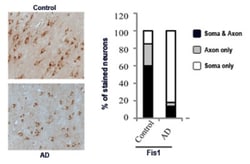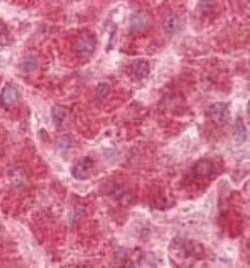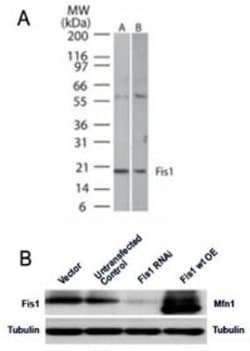Promotional price valid on web orders only. Your contract pricing may differ. Interested in signing up for a dedicated account number?
Learn More
Learn More
TTC11 Antibody, Novus Biologicals™


Rabbit Polyclonal Antibody
Supplier: Novus Biologicals NB10056646SS
Description
TTC11 Polyclonal specifically detects TTC11 in Human, Mouse, Rat samples. It is validated for Western Blot, ELISA, Immunohistochemistry, Immunohistochemistry-Paraffin, Knockdown Validated.Specifications
| TTC11 | |
| Polyclonal | |
| Western Blot 1:500 - 1:1000, ELISA reported in scientific literature (PMID 27494529), Immunohistochemistry, Immunocytochemistry/Immunofluorescence reported in scientific literature (PMID 34999205), Immunohistochemistry-Paraffin 1:100. Use reported in scientific literature (Wang et al (2009)), KnockDown Validated | |
| Q9Y3D6 | |
| FIS1 | |
| Amino acids 11-25 of human Fis1 protein were used as the immunogen. | |
| 0.05 mL | |
| Apoptosis, Cancer, Mitochondrial Fusion Proteins, Tumor Suppressors | |
| 51024 | |
| Human, Mouse, Rat | |
| Antisera |
| Western Blot, ELISA, Immunohistochemistry, Immunocytochemistry, Immunofluorescence, Immunohistochemistry (Paraffin), KnockDown | |
| Unconjugated | |
| Whole antisera with PBS and 0.05% BSA with 0.05% Sodium Azide | |
| CGI-135, Fis1, FIS1 homolog, fission 1 (mitochondrial outer membrane) homolog (S. cerevisiae), fission 1 (mitochondrial outer membrane) homolog (yeast), H_NH0132A01.6, hFis1, mitochondrial fission 1 protein, tetratricopeptide repeat domain 11, Tetratricopeptide repeat protein 11, TTC11TPR repeat protein 11 | |
| Rabbit | |
| Unpurified | |
| RUO | |
| Primary | |
| The NCBI accession number for Fis1 is NP_057152. The amino acid sequence used as immunogen is 93% homologous in dog, 73% in mouse and rat, and 66% in chimp (a 512 AA protein). | |
| Store at 4C short term. Aliquot and store at -20C long term. Avoid freeze-thaw cycles. | |
| IgG |
Product Content Correction
Your input is important to us. Please complete this form to provide feedback related to the content on this product.
Product Title
For Research Use Only
Spot an opportunity for improvement?Share a Content Correction


